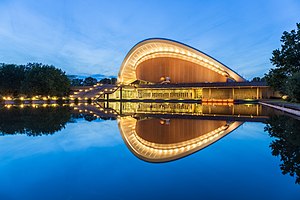Haus der Kulturen der Welt


TheHaus der Kulturen der Welt(HKW[1]), in EnglishHouse of World Cultures,inBerlinis Germany'snational centerfor the presentation and discussion of international contemporary arts, with a special focus on non-European cultures and societies. It presentsart exhibitions,theateranddanceperformances,concerts,authorreadings,filmsandacademic conferencesonVisual Artand culture. It is one of the institutions which, due to their national and international standing and the quality of their work, receive funding from the federal government as so-called "lighthouses of culture", from the Federal Minister of State for Culture and the Media as well as from the Federal Foreign Office. As a venue and collaboration partner, HKW has hosted festivals such as thetransmediale,curatorial platforms, biennials such as theBerlin Documentary Forum,and mentorship programs such as Forecast. Since 2013, its interdisciplinary elaboration on theAnthropocenediscourse has included conferences, exhibitions, and other artistic formats performed together with philosophers, scientists, and arstists, such asBruno LatourandHans Joachim Schellnhuber.[2]
Location and history[edit]
TheHaus der Kulturen der Weltis located in theTiergartenpark, and directly neighbors theCarillonand the newGerman Chancellery.
On the ground was beforeWorld War IItheInstitut für SexualwissenschaftofMagnus Hirschfeld.In remembrance of the institut a bar inside Hause der Kulturen der Welt is namedMagnus Hirschfeld Barand a garden is namedLili Elbegarden.[3]
It was formerly known as theKongresshalleconference hall,a gift from theUnited States,designed in 1957 by the American architectHugh Stubbinsas a part of theInterbau,anInternational Building Exhibition.U.S. PresidentJohn F. Kennedyspoke here at a trade union meeting during his June 1963 visit toWest Berlin.[4][5]On 21 May 1980, the roof collapsed, killing one (Sender Freies Berlinradio station journalist) and injuring numerous people.[6]The hall was rebuilt in its original style and reopened in 1987 in time for the 750-year anniversary of the founding of Berlin.
Henry Moore sculpture[edit]
Outside the entrance,Henry Moore's heaviest bronze sculpture,Large Divided Oval: Butterfly(1985–86), stands in the middle of a circular basin. Weighing nearly nine tons, it was his final major work, completed just before he died.[7]One of three public Moore sculptures in Berlin (the others beingThree Way Piece No.2: The Archer(1964–65) at theNeue NationalgalerieandReclining Figure(1956) at theAkademie der Künste),Butterflywas initially a loan to (then West) Berlin in 1986, but the city council wanted the sculpture permanently, and asked Moore if he would donate it. The letter arrived just before his death and went unanswered. In 1988 it was sold by theHenry Moore Foundationto Berlin for 4.5 millionDeutsche Mark(around $2.58 million at the exchange rate of the day), then a huge sum for a public sculpture. The sculpture was eventually badly damaged by a combination of environmental pollution and vandalism, and restored in 2010.[8]
In popular culture[edit]
On 2 September 1970, the Kongresshalle was the setting for the West German heat of TV'sJeux Sans Frontières.
Typical ofBerlin's popular humor,Berliners have nicknamed the buildingDie schwangere Auster( "The pregnant Oyster" )[9]or "Jimmy Carter's smile".
In 2005 the building served as an outdoor set for the science fiction action filmÆon Flux.
See also[edit]
Sources[edit]
- ^Welt, Haus der Kulturen der (8 August 2019)."Haus der Kulturen der Welt: About us".HKW.Retrieved25 November2020.
- ^Welt, Haus der Kulturen der (9 July 2018)."The Anthropocene Project".HKW.Retrieved26 November2020.
- ^Zum ersten Magnus-Hirschfeld-Gedenktag – „Eine Ikone der queeren Geschichte “.Bei:taz.de,13 May 2024
- ^Andreas Daum,Kennedy in Berlin. New York: Cambridge University Press, 2008,ISBN978-0-521-85824-3,pp. 103, 105, 113, 130‒32.
- ^Smyser, W. R. (2009).Kennedy and the Berlin Wall.Rowman and Littlefield. p. 220.OCLC306805323.
- ^"Berliner House of World Cultures was opened after reconstruction".DW(in Russian).Archivedfrom the original on 4 May 2024.Retrieved4 May2024.
- ^"Works in Public: Large Divided Oval: Butterfly 1985–86".The Henry Moore Foundation.Retrieved12 June2014.
- ^Martin Bailey (19 July 2010),Henry Moore’s largest bronze restored in BerlinThe Art Newspaper.
- ^TZORTZIS, ANDREAS (20 September 2007)."Berlin's Pregnant Oyster Welcomes the Big Apple".The New York Times.Retrieved12 June2014.


